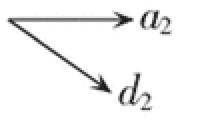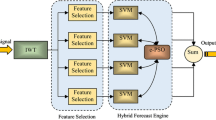Abstract
Mid-term load forecasting (MTLF) is used to predict the loads for the durations from a week up to a year. Many methods have been used for selecting the best input data which is a critical issue in load forecasting. Recently, two separate approaches based on fuzzy logic system and support vector machine have shown better results compared to statistical techniques. The main purpose of this paper is to employ a novel hybrid approach based on wavelet support vector machines (WSVM) and chaos theory for MTLF. First, kernel-based fuzzy clustering technique and two-step correlation analysis are separately used for selecting training samples. Moreover, chaos theory is used to find the optimum time delay constant and embedding dimension of the load time series. Furthermore, genetic algorithm is employed to optimize the parameters of the WSVM model. EUNITE competition data and Iran power system data are selected to test the proposed method. The results show the efficiency of the suggested method compared with the other methods.










Similar content being viewed by others
References
Alamaniotis M, Ikonomopoulos A, Tsoukalas LH (2012) Evolutionary multiobjective optimization of kernel-based very-short-term load forecasting. IEEE Trans Power Syst 27(3):1477–1484. doi:10.1109/tpwrs.2012.2184308
Çevik H, Çunkaş M (2015) Short-term load forecasting using fuzzy logic and ANFIS. Neural Comput Appl 26(6):1355–1367. doi:10.1007/s00521-014-1809-4
Sugianto LF, Lu X-B (2002) Demand forecasting in the deregulated market: a bibliography survey. School of Business Systems, Victoria
Fan S, Chen L, Lee WJ (2008) Short-term load forecasting using comprehensive combination based on multi-meteorological information. In: Industrial and commercial power systems technical conference, 2008. ICPS 2008. IEEE/IAS, 4–8 May 2008, pp 1–7. doi:10.1109/icps.2008.4606288
Gonzalez-Romera E, Jaramillo-Moran MA, Carmona-Fernandez D (2006) Monthly electric energy demand forecasting based on trend extraction. IEEE Trans Power Syst 21(4):1946–1953. doi:10.1109/tpwrs.2006.883666
Khosravi A, Nahavandi S, Creighton D, Srinivasan D (2012) Interval type-2 fuzzy logic systems for load forecasting: a comparative study. IEEE Trans Power Syst 27(3):1274–1282. doi:10.1109/tpwrs.2011.2181981
Feinberg E, Genethliou D (2005) Load forecasting. In: Chow J, Wu F, Momoh J (eds) Applied mathematics for restructured electric power systems. Power electronics and power systems. Springer, New York, pp 269–285
Zhao M, Fu C, Ji L, Tang K, Zhou M (2011) Feature selection and parameter optimization for support vector machines: a new approach based on genetic algorithm with feature chromosomes. Expert Syst Appl 38(5):5197–5204. doi:10.1016/j.eswa.2010.10.041
Kwang-Ho K, Hyoung-sun Y, Yong-Cheol K (2000) Short-term load forecasting for special days in anomalous load conditions using neural networks and fuzzy inference method. IEEE Trans Power Syst 15(2):559–565. doi:10.1109/59.867141
Ding N, Besanger Y, Fdr Wurtz (2015) Next-day MV/LV substation load forecaster using time series method. Electr Power Syst Res 119:345–354. doi:10.1016/j.epsr.2014.10.003
Amaral LF, Souza RC, Stevenson M (2008) A smooth transition periodic autoregressive (STPAR) model for short-term load forecasting. Int J Forecast 24(4):603–615. doi:10.1016/j.ijforecast.2008.08.006
Tsekouras GJ, Dialynas EN, Hatziargyriou ND, Kavatza S (2007) A non-linear multivariable regression model for midterm energy forecasting of power systems. Electr Power Syst Res 77(12):1560–1568. doi:10.1016/j.epsr.2006.11.003
Ghayekhloo M, Menhaj MB, Ghofrani M (2015) A hybrid short-term load forecasting with a new data preprocessing framework. Electr Power Syst Res 119:138–148. doi:10.1016/j.epsr.2014.09.002
López M, Valero S, Senabre C, Aparicio J, Gabaldon A (2012) Application of SOM neural networks to short-term load forecasting: the Spanish electricity market case study. Electr Power Syst Res 91:18–27. doi:10.1016/j.epsr.2012.04.009
Dong J-r, Zheng C-y, Kan G-y, Zhao M, Wen J, Yu J (2015) Applying the ensemble artificial neural network-based hybrid data-driven model to daily total load forecasting. Neural Comput Appl 26(3):603–611. doi:10.1007/s00521-014-1727-5
Sheikhan M, Mohammadi N (2012) Neural-based electricity load forecasting using hybrid of GA and ACO for feature selection. Neural Comput Appl 21(8):1961–1970. doi:10.1007/s00521-011-0599-1
Tsekouras GJ, Hatziargyriou ND, Dialynas EN (2006) An optimized adaptive neural network for annual midterm energy forecasting. IEEE Trans Power Syst 21(1):385–391. doi:10.1109/TPWRS.2005.860926
Li Y-y, Niu D-x (2005) An optimum credibility based integrated optimum gray neural network model of monthly power load forecasting. Power Syst Technol 5:16–19
Chang P-C, Fan C-Y, Lin J-J (2011) Monthly electricity demand forecasting based on a weighted evolving fuzzy neural network approach. Int J Electr Power Energy Syst 33(1):17–27. doi:10.1016/j.ijepes.2010.08.008
Lloyd JR (2014) GEFCom2012 hierarchical load forecasting: gradient boosting machines and Gaussian processes. Int J Forecast 30(2):369–374. doi:10.1016/j.ijforecast.2013.07.002
Smola AJ, Schölkopf B (2004) A tutorial on support vector regression. Stat Comput 14(3):199–222
Hippert HS, Bunn DW, Souza RC (2005) Large neural networks for electricity load forecasting: are they overfitted? Int J Forecast 21(3):425–434. doi:10.1016/j.ijforecast.2004.12.004
Bo-Juen C, Ming-Wei C, Chih-Jen L (2004) Load forecasting using support vector machines: a study on EUNITE competition 2001. IEEE Trans Power Syst 19(4):1821–1830. doi:10.1109/tpwrs.2004.835679
Espinoza M, Suykens JK, Moor B (2006) Fixed-size least squares support vector machines: a large scale application in electrical load forecasting. CMS 3(2):113–129. doi:10.1007/s10287-005-0003-7
Abbas SR, Arif M (2006) Electric load forecasting using support vector machines optimized by genetic algorithm. In: Multitopic conference, 2006. INMIC ‘06. IEEE, 23–24 December 2006, pp 395–399. doi:10.1109/inmic.2006.358199
Hong W-C (2011) Electric load forecasting by seasonal recurrent SVR (support vector regression) with chaotic artificial bee colony algorithm. Energy 36(9):5568–5578. doi:10.1016/j.energy.2011.07.015
Duan P, Xie K, Guo T, Huang X (2011) Short-term load forecasting for electric power systems using the PSO–SVR and FCM clustering techniques. Energies 4(1):173–184
S-x Yang, Cao Y, Liu D, C-f Huang (2011) RS-SVM forecasting model and power supply-demand forecast. J Cent South Univ Technol 18(6):2074–2079. doi:10.1007/s11771-011-0945-6
Wu Q (2010) Power load forecasts based on hybrid PSO with Gaussian and adaptive mutation and Wv–SVM. Expert Syst Appl 37(1):194–201. doi:10.1016/j.eswa.2009.05.011
Wu Q (2011) Hybrid model based on wavelet support vector machine and modified genetic algorithm penalizing Gaussian noises for power load forecasts. Expert Syst Appl 38(1):379–385
Wu Z-d, Xie W-x, Yu J-p (2003) Fuzzy C-means clustering algorithm based on kernel method. In: Proceedings of fifth international conference on computational intelligence and multimedia applications, 2003. ICCIMA 2003, 27–30 September 2003, pp 49–54. doi:10.1109/iccima.2003.1238099
Alamaniotis M, Bargiotas D, Tsoukalas LH (2016) Towards smart energy systems: application of kernel machine regression for medium term electricity load forecasting. SpringerPlus Eng 5:1–15. doi:10.1186/s40064-016-1665-z
Xiaowei Y, Guangquan Z, Jie L, Jun M (2011) A kernel fuzzy c-means clustering-based fuzzy support vector machine algorithm for classification problems with outliers or noises. IEEE Trans Fuzzy Syst 19(1):105–115. doi:10.1109/tfuzz.2010.2087382
Amjady N, Keynia F (2008) Mid-term load forecasting of power systems by a new prediction method. Energy Convers Manag 49(10):2678–2687. doi:10.1016/j.enconman.2008.04.008
Elattar EE, Goulermas J, Wu QH (2010) Electric load forecasting based on locally weighted support vector regression. IEEE Trans Syst Man Cybern Part C Appl Rev 40(4):438–447. doi:10.1109/tsmcc.2010.2040176
Lau KW, Wu QH (2008) Local prediction of non-linear time series using support vector regression. Pattern Recogn 41(5):1539–1547. doi:10.1016/j.patcog.2007.08.013
Cao L (1997) Practical method for determining the minimum embedding dimension of a scalar time series. Physica D 110(1–2):43–50. doi:10.1016/S0167-2789(97)00118-8
Müller K-R, Smola AJ, Rätsch G, Schölkopf B, Kohlmorgen J, Vapnik V (1997) Predicting time series with support vector machines. In: Artificial neural networks—ICANN’97. Springer, pp 999–1004
Li Z, Weida Z, Licheng J (2004) Wavelet support vector machine. IEEE Trans Syst Man Cybern B Cybern 34(1):34–39. doi:10.1109/tsmcb.2003.811113
Smola AJ (1996) Regression estimation with support vector learning machines. Master’s thesis, Technische Universit at M unchen
Eunite (2001) European network of excellence on intelligent technologies for smart adaptive systems. http://neuron.tuke.sk/competition/. Accessed 1 Mar 2012
IGMCo (2008) Iran Grid Management Co. http://www.igmc.ir/. Accessed 20 Apr 2008
Iranian-Calendar-Center (2012) Institute of Geophysics, University of Tehran. http://calendar.ut.ac.ir/. Accessed 20 Mar 2012 (in Farsi)
El-Attar EE, Goulermas JY, Wu QH (2009) Forecasting electric daily peak load based on local prediction. In: Power & energy society general meeting, 2009. PES ‘09. IEEE, 26–30 July 2009, pp 1–6. doi:10.1109/pes.2009.5275587
Haishan W, Xiaoling C (2006) Power load forecasting with least squares support vector machines and chaos theory. In: The sixth world congress on Intelligent control and automation, 2006. WCICA 2006, 0-0 0 2006. pp 4369–4373. doi:10.1109/wcica.2006.1713202
Author information
Authors and Affiliations
Corresponding author
Ethics declarations
Conflict of interest
The authors declare that they have no conflict of interest.
Rights and permissions
About this article
Cite this article
Alirezaei, H.R., Salami, A. & Mohammadinodoushan, M. A study of hybrid data selection method for a wavelet SVR mid-term load forecasting model. Neural Comput & Applic 31, 2131–2141 (2019). https://doi.org/10.1007/s00521-017-3171-9
Received:
Accepted:
Published:
Issue Date:
DOI: https://doi.org/10.1007/s00521-017-3171-9




